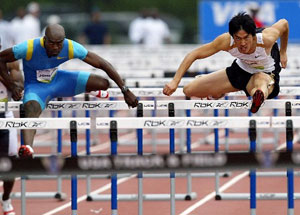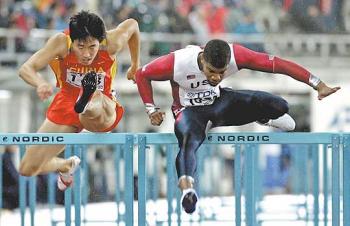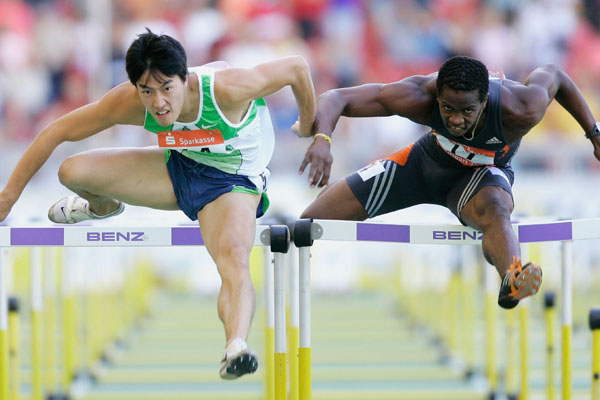Okay, so I’m looking up the results of the World Athletics Final this past weekend, and after scrolling down past a bunch of stuff about Asafa Powell, Sanya Richards, Jeremy Wariner, Tyson Gay, and all these other non-hurdlers, I finally got down to what I was looking for: the men’s 110m high hurdles. The top three finishers were as follows:
1. Liu Xiang – 12.93
2. Dayron Robles – 13.00
3. Allen Johnson – 13.01
In finishing second, Robles, the young Cuban tied his country’s national record, originally set by Anier Garcia on his way to a gold medal performance at the Sydney Olympics in 2000. The 20-year-old Robles is quietly having one of the best seasons in the history of the event, as he has done everything imaginable except break 13.00 and defeat Liu Xiang. I say that he is “quietly” having an outstanding season because of the loudness of Xiang’s season. His WAF victory marked his second sub-13.00 race of the season, his first being the world-record-shattering 12.88 in Zurich in August. Meanwhile, after seeming to be all but dead in the water for the first three quarters of the outdoor season, Johnson has resurrected himself by re-establishing himself as still one of the best hurdlers in the world, by golly.
For the purposes of this article, I first want to focus on Xiang and Johnson, and take a look at their respective hurdling styles. While I would still argue that Johnson is the greatest high hurdler ever, I would also state that Xiang is the greatest of the past three years. By the end of 2008 it could very well be undeniable that Xiang is the greatest ever. We shall see. In the meantime, I find it fascinating that Xiang, at 6-2 (1.89m) and Johnson, at 5-10 (1.80m) have so many similarities in their hurdling techniques, and that, in spite of the difference in height, they hurdle in more or less the same manner. The subtle difference in thier styles can be viewed as adjustments each has made to be being taller than most hurdlers (in the case of Xiang), or smaller than most hurdlers (in the case of Johnson). The fact that both have achieved such enormous success over a significant span of time makes them worth analyzing as models of technical excellence. Let’s break it down:


The above photos are from the Reebok Invitational in New York in 2005. Johnson won this race by a very slim margin. These photos work well to serve the purpose of demonstrating the similarities and differences in Johnson’s and Xiang’s technique. Let’s start at the top and work our way down. In the photo on the left, both hurdlers have their chin up and their eyes facing the next hurdle. Neither of them is ducking their head down, which means they are both getting the maximum benefit from their lean, increasing their ability to accelerate off the hurdle. “Chest over thigh” is the mantra that Johnson’s former coach, Curtis Frye, always preaches, and we can see in these photos that both hurdlers are employing this aspect of hurdling technique. Johnson, who is slightly ahead in these photos, is beginning his descent back to the ground, so he is beginning to uncoil, to rise back up to full height, so it isn’t as obvious with him. Such is the nature of still photos. But with Xiang, who is on top of the hurdle in the photo on the left, it is quite clear that he is pushing his chest down over his lead-leg thigh, which will quicken the snap of the lead leg, and help create a “boom!” feeling of thrust and power when he touches back down.
Now let’s look at the arms. The lead arms of both hurdlers are virtually identical: bent at the elbow, close to the body, allowing just enough room for the trail leg to squeeze through. No wasted motion. No swinging upward, no swinging laterally across the body, no swinging backward behind the torso. Really, you can’t get your lead arm any tighter while clearing a hurdle. I know I’m being very picky on this one, but I prefer Xiang’s lead arm over Johnson’s in these photos because Xiang’s thumb is closer to pointing straight up, whereas the palm of Johnson’s lead hand is sweeping straight back, with the thumb pointing down. My thinking is, the closer you can keep everything in hurdling to how it is when sprinting, the better. Even if it only takes Johnson .001 to get that thumb pointing back upward when he returns to sprinting motion, that .001 over ten hurdles equals .01, which could be the difference in a race.
In the trail arms, there is a noticeable difference, but it’s really inconsequential. Between hurdles, Johnson tends to run with his elbows wider than most hurdlers, so that tendency extends to when he is going over a hurdle. In these photos, you can see that the elbow of his trail arm is pointing outward, which is not really ideal, but it works for him, because, when he punches that hand back up, it’s going directly back into sprinting motion without crossing his body. If I were teaching trail arm motion, however, I would probably look to Xiang’s style as seen in these photos. With Xiang, the elbow pulls straight back, with the hand resting on or directly behind the butt-cheek.
Now for the lead leg. With both hurdlers, the knee is ever-so-slightly bent, making for a fluid rotary motion throughout hurdle clearance, with no pause on top of the hurdle or on the way down. Both hurdlers also are pointing the toe of the lead foot upward, so that when they snap down and complete the rotation of the lead, they will land on the ball of the foot, the same as they would in a normal sprinting stride. Also, neither hurdler is wasting any time over the hurdle. They are both “skimming” the hurdle, clearing it as low as possible without actually hitting it. It’s a beautiful thing to watch at full speed.
The trail legs of both athletes are stellar as well. Ideally, you want the trail leg to similate the action of the lead leg as closely as possible. It is impossible to do this in a literal sense, but thinking literally doesn’t make you run faster. How things feel matters more than how things are. When the trail leg is really sharp, tight, and efficient, it creates the feeling that you are merely sprinting over hurdles, not hurdling over hurdles. The lead leg does not provide that feeling; the trail leg does. In these two photos, both Xiang and Johnson show how it’s done. First of all, just as the toes of the lead leg stay pointing up, so do the toes of the trail leg. Keeping the toes pulled prevents them from catching the crossbar, which can cause major balance problems and can even lead to a crash. Besides that, the pulled toes help to maintain fluidity and rhythm – essential components to effective hurdling. Also, take a look at where the knee of both hurdlers’ trail leg is in relation to the foot of the trail leg. The knee is higher, which is exactly how it should be. The knee being higher than the foot means that the leg is driving upward in a tight motion underneath the armpit. No excess width in the groin area is being created. The trail leg is moving in an up-and-down motion as opposed to an up-around-and-down motion. Much more efficient, much more rhythmic, and a whole heck of a lot faster. For a look at how Xiang’s trail leg will look upon landing, check out the photo below:

Here, he has almost touched down, and the knee of the trail leg, still maintaining its position in front of the foot, is almost all the way back in front as it returns to sprinting motion. Also the chin is still up, the eyes are still facing the next hurdle, the chest is still over the thigh. Beautiful! The alignment, the pinpoint precision of the angles, is breathtaking.
Now let’s take a look at a photo of Xiang going up against another world-class hurdler, Terrence Trammell:

There are several things I like about Trammell’s technique in this photo. Firstly, the trail arm is in excellent position to resume sprinting motion upon touchdown. The thumb is pointing up, and the elbow is not flaring out too far. The lead leg is looking good too. The knee is bent, the toes are pointing up, and there is no space between his hamstring and the crossbar. Trail leg looks good too. Excellent angles, knee is above the foot, toes are pointing up enough that there’s no danger of snagging a hurdle. What I don’t like about Trammell’s technique here is how he dips his head down, causing him to lean more from his upper back instead of from his lower back and abdominal region. Also, the lead arm, though not sloppy, is flaring out farther from the body than is necessary to allow the trail leg room to drive upward. Trammell, a phenomenal flat sprinter, is strong enough and fast enough that he isn’t affected by such minor technical flaws, but I do wonder if he wouldn’t already have run under 13.00 by now if he had corrected them.
Finally, let’s take a look at Xiang vs. Robles at the World Athletics Final. Again, Xiang won, 12.93 to 13.00.

In this photo, Xiang’s angles are on point once again. His trail arm is looking a little bit less precise than usual, which might have something to do with the fact that he and Robles are making contact with each other. But everything else – the lead leg, the trail leg, the hips, the chest, the lead arm, the chin, the eyes – it’s all right where it needs to be. Observing this photo of Robles, it’s scary to think what he might do later in his career if he’s already running 13.00 looking like this. Though he is on his way down off the hurdle, his lead leg is locked at the knee. And his trail leg knee is still below the crossbar, still below the foot, which means that it will come around much more widely than would be considered efficient. His lead arm looks good, but the trail arm is wider and higher than necessary. Both of his shoulders are raised too high, and his hips are tilted toward the lead-leg side of the lane. But we all know from experience that a fighting spirit and the will to win can make up for a whole lot of technical flaws. Still, when competing against the best, the technical flaws must be addressed and corrected. Right now, Xiang is the best 110 hurdler in the world because of his technical mastery of the event, and because of his ability to fit his speed into the three steps between the hurdles. But that’s a topic for another day.
© 2006 Steve McGill
